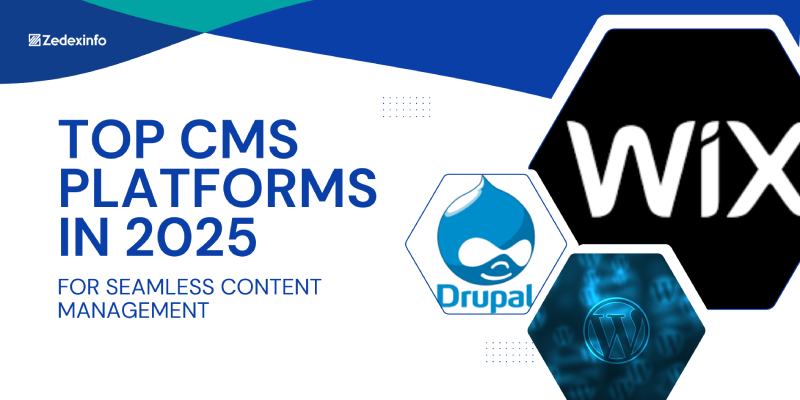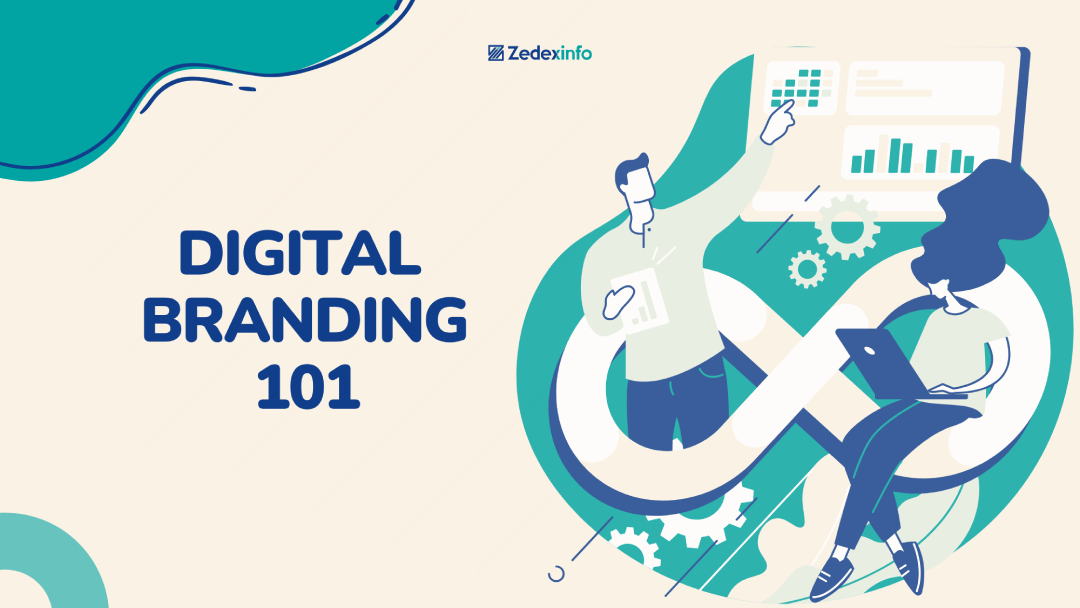In 2025, as digital landscapes grow more complex and omnichannel strategies become the norm, managing content is more crucial than ever. Selecting the right Content Management System (CMS) is essential to create, organize, and distribute content seamlessly across platforms. Modern CMS platforms go beyond just hosting websites, they’re equipped with AI-driven personalization, advanced analytics, and integration capabilities that streamline everything from marketing to eCommerce. Some of the top CMS platforms for 2025 include WordPress, HubSpot, Contentful, Wix, and Drupal, each catering to unique needs, from blogs and business sites to large-scale enterprise applications.
These platforms offer flexibility to meet diverse needs. Small businesses benefit from drag-and-drop simplicity, while developers prefer headless architecture for multi-platform audiences. Platforms like Magento and Ghost provide tailored solutions for eCommerce and content publishing, blending specialized tools with intuitive design. Trends like AI personalization, omnichannel support, and stronger security make choosing the right CMS platform crucial for growth. Here’s a guide to the top CMS platforms in 2025 to help you find the best fit for your needs.
WordPress:
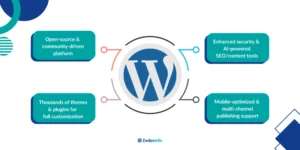
WordPress remains the leading CMS in 2025, known for its flexibility, extensive plugin ecosystem, and user-friendly interface that suits users from beginners to seasoned developers. Originally designed as a blogging platform, WordPress has become a powerful CMS that handles everything from tiny blogs to complex enterprise websites. With thousands of themes and plugins available, users can customize virtually every aspect of their site without extensive coding knowledge. The latest updates also improve security features and AI tools for SEO, content analysis, and automated recommendations, making content management more intuitive and effective.
A key strength of WordPress is its community-driven nature. With a vast support network and frequent updates, it continuously adapts to new technological demands. Users benefit from an open-source framework, allowing custom developments, API integrations, and mobile-friendly site optimization. In 2025, WordPress also prioritized accessibility and multi-channel content publishing, allowing businesses to reach audiences across platforms. With its solid foundations and a commitment to ongoing innovation, WordPress is ideal for small business websites, large corporate sites, eCommerce stores, and dynamic content-focused blogs looking for flexibility and scalability.
HubSpot CMS:
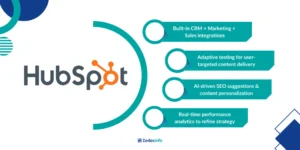
HubSpot CMS is a powerful, all-in-one platform for businesses prioritizing marketing and customer engagement. Built on HubSpot’s inbound marketing philosophy, this CMS integrates seamlessly with HubSpot’s CRM, marketing, sales, and service tools, allowing businesses to create, optimize, and personalize content based on visitor behavior. With its intuitive drag-and-drop editor and pre-designed themes, creating professional websites without coding becomes effortless. HubSpot CMS also offers adaptive testing and innovative content tools, which tailor content to specific user segments, improving user experience and engagement.
What sets HubSpot CMS apart is its deep analytics and insights capabilities, allowing businesses to track real-time content performance and refine their strategies. In 2025, HubSpot’s CMS continues to innovate with AI-driven features that suggest content improvements, SEO optimizations, and personalization strategies. With advanced security features and scalability, HubSpot CMS is ideal for growing businesses and marketing teams seeking a streamlined content management experience with integrated marketing and sales functionalities. For companies focused on lead generation and customer-centric marketing, HubSpot CMS offers a comprehensive and robust solution that enhances every stage of the customer journey.
Contentful:
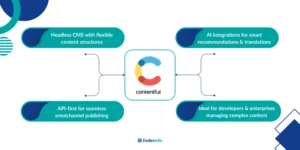
Contentful is a headless CMS that helps developers and businesses create flexible content structures for multiple platforms. Unlike traditional CMS tools, it separates content from design, allowing developers to build front-end experiences independently. With its API-first approach, Contentful is perfect for delivering content to websites, mobile apps, IoT devices, and more. Its customizable content model lets teams easily manage complex content without layout or display restrictions.
In 2025, Contentful continues to enhance its value for enterprise users with multi-environment support, powerful integrations, and robust scalability, accommodating teams managing high volumes of content across various channels. It supports omnichannel strategies, where businesses can publish consistent messaging and experiences anywhere their users engage. Contentful’s expanding plugin ecosystem also includes integrations with AI and machine learning tools for automated content recommendations, translations, and optimization insights. With high customizability and control, Contentful is ideal for enterprises and development teams prioritizing agility, enabling them to build scalable digital experiences and respond quickly to market needs and audience preferences.
Wix:
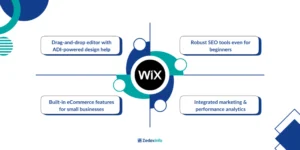
Wix is a popular website builder and a top CMS platform known for its ease of use and advanced customization. Its drag-and-drop editor allows users to create professional websites without coding. With pre-designed templates and flexible customization, anyone can design a site to fit their needs. Wix also supports eCommerce, making it great for small businesses and entrepreneurs. In 2025, its AI-powered design feature (ADI) remains a standout, offering layout suggestions and smart design adjustments.
Beyond ease of design, Wix offers robust built-in SEO tools, ensuring that even first-time site creators can optimize their content for search engines. In addition, Wix includes tools for blogging, marketing integrations, and analytics, giving users insights into site performance and visitor behavior. Its versatility extends to mobile optimization and secure hosting, with SSL certificates and performance monitoring ensuring a seamless experience. Wix’s user-friendly design, AI-driven tools, and a broad set of features make it ideal for individuals and small businesses seeking a straightforward yet powerful CMS to establish their online presence.
Drupal:
Drupal is a robust open-source CMS celebrated for its flexibility and scalability. This cms platform stands out as a premier choice for intricate websites and applications that demand custom configurations. It is widely used by government agencies, schools, and large businesses. Plus, it offers advanced features like user role management, content structuring, and strong security. Its modular design lets developers add functionality using thousands of modules without changing core code. With API capabilities, developers can create custom workflows, integrate third-party services, and deliver content across platforms. In 2025, Drupal remains one of the most customizable CMS platforms.
Drupal excels at managing large content volumes and handling high traffic. This makes it perfect for sites needing complex data management and reliable performance. In 2025, new AI-driven modules will automate content recommendations, improve search, and enhance user experience. Its multilingual and accessibility features make it great for global organizations. While Drupal has a steeper learning curve, it offers high control, security, and scalability, perfect for projects requiring power and precision.
Magento (Adobe Commerce):
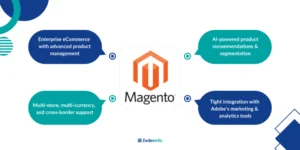
Magento, now Adobe Commerce, is a leading eCommerce CMS. It offers tools to manage complex online stores with ease. Known for its scalability, it supports large product catalogs, advanced inventory management, and detailed order processing. Businesses can create custom shopping experiences with flexible product setups, pricing rules, and discounts. Adobe Commerce supports multiple storefronts from one backend, multi-warehouse inventory, and cross-border eCommerce with various languages and currencies. By 2025, advanced AI will power personalized shopping with smarter recommendations, customer segmentation, and targeted marketing.
Adobe Commerce is known for strong security and performance, perfect for high-traffic, enterprise stores. It integrates with Adobe’s marketing and analytics tools, helping businesses optimize the customer journey. With built-in payment solutions, real-time reporting, and marketing automation, it supports growth and efficiency. While it has a learning curve and needs technical expertise for customization, it’s a top choice for secure and personalized eCommerce experiences.
Ghost:
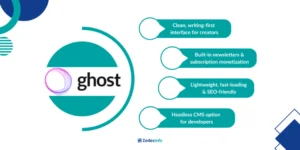
Ghost is a streamlined, open-source CMS uniquely designed for bloggers, writers, and publishers focused on delivering content-driven websites. Known for its minimalist design and writing-first approach, Ghost provides a distraction-free environment that prioritizes content creation. Ghost’s built-in SEO tools, clean HTML, and lightweight design ensure fast-loading content that ranks well on search engines. The markdown editor makes text formatting simple. Membership and subscription features help creators monetize with subscriber-only content, newsletters, and communities, all in one platform.
In 2025, Ghost remains a top choice for creators who want simplicity and functionality. It offers tools like customizable themes, email newsletters, and analytics without the bulk of traditional CMS platforms. Its API and headless CMS let developers connect with front-end frameworks to publish across channels. Ghost’s SEO-friendly features ensure a fast, reader-focused setup. With simplicity, speed, and monetization options, it’s perfect for independent writers, niche publishers, and content-driven organizations.
Conclusion:
As we head into 2025, picking the right CMS is more important than ever. WordPress, HubSpot, and Magento each bring unique strengths for eCommerce and content publishing. With new advances in AI, security, and omnichannel tools, the right CMS platform can boost your digital presence and fuel growth. Knowing what each platform offers is key to staying ahead online.
